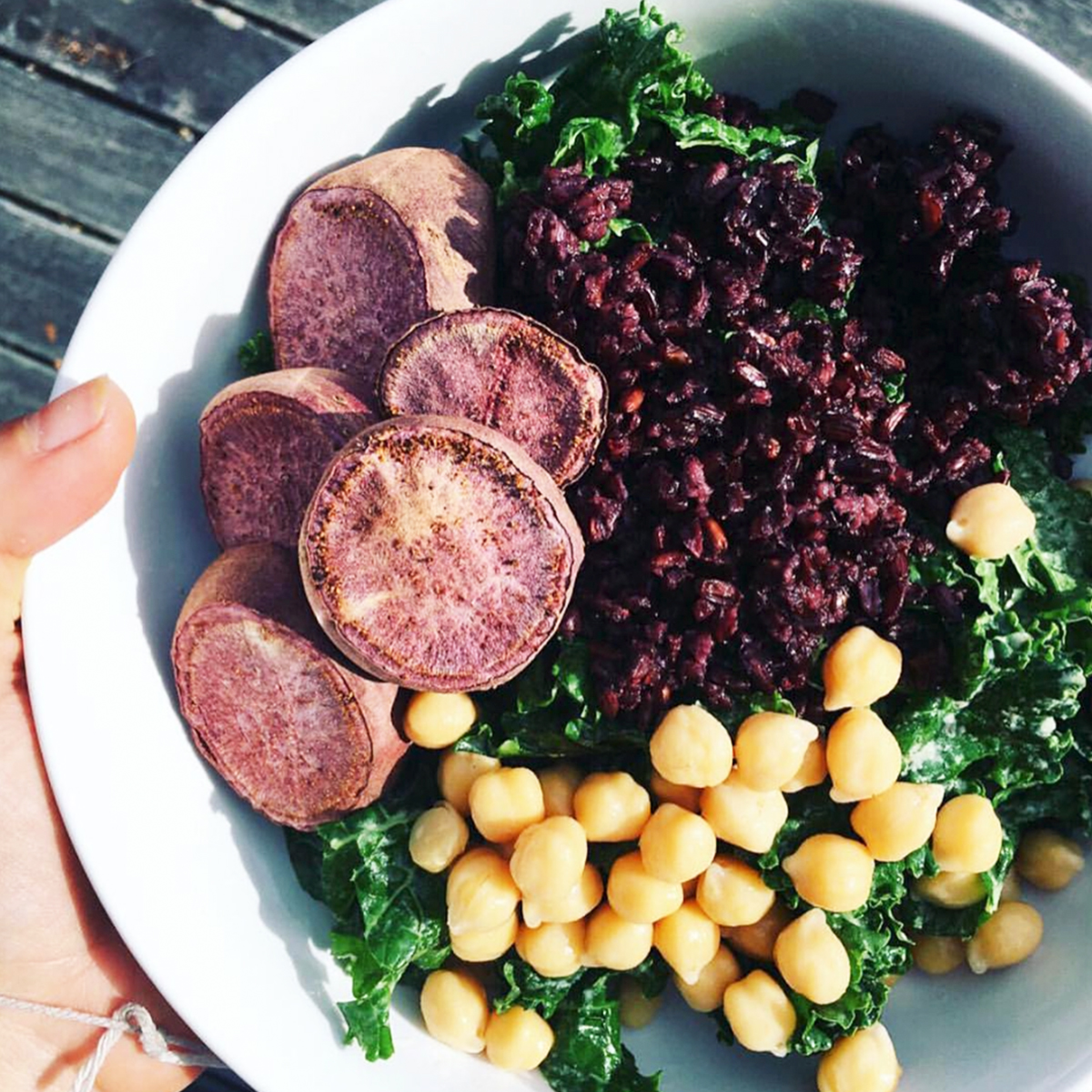6 Ways I'm Changing My Diet to Help Heal My Hormones


A few months ago, I was diagnosed with a chronic hormonal endocrine disorder—polycystic ovarian syndrome—and it's kind of rocked my world. I don't exactly mean that in the most positive of ways: On the one hand, I finally have a sturdy (albeit intimidating) explanation for a series of symptoms that have impacted my life for years (the most concerning of which has been a missing period). On the other hand, it's not a "curable" disorder, and treatment pretty much consists of figuring out ways to manage symptoms. Which, as I'm learning, involves a lot of trial and error.
I dealt with an eating disorder in high school, and ever since, I've had quite the diabolical relationship with my period; now it seems to have dismissed itself completely. Losing a period is a common symptom for those with eating disorders—after all, your body's sole purpose becomes keeping you alive, not preparing for the creation of a baby. Understandable. But now that I've been in "recovery" for years and put a lot of effort into getting my body back in fighting shape both mentally and physically, a period that's still ghosting me has been frustrating. Pair that concern with other symptoms like hormonal acne, anxiety, fatigue, insomnia, thinning hair, headaches, and roller coaster esque mood swings, and well, it's been interesting. But mostly I've just wanted answers.
And finally, in a way, I have them. Or rather, I have a diagnosis. As I mentioned, PCOS isn't "curable" per se, but there are things that can be done to help manage symptoms. One such strategy is medication, which, as someone who hates taking a prescription unless absolutely necessary, wasn't appealing to me. A more holistic strategy is committing to some lifestyle changes. Focusing on my diet and learning to transform restriction into variety and excitement about food was one practice that truly helped me heal from my eating disorder. So bearing that in mind, I did some research and found out making some strategic changes to my diet could soothe my symptoms and might even help get my period back. But I was going to need some guidance.
Almost immediately, I reached out to holistic nutritionist and hormone expert Alisa Vitti—aka the period whisperer in the word of holistic and functional health. As the author of WomanCode: Perfect Your Cycle, Amplify Your Fertility, Supercharge Your Sex Drive, and Become a Power Source ($13), she has some of the best know-how when it comes to harnessing lifestyle practices in order to have a happy, healthy, and present period. Excited, I jumped on a call with her and explained my background (eating disorder), my current situation (no period, work, life, other symptoms), and lastly, my goals (period, managed symptoms, etc.), which I was hoping to achieve with an emphasis on diet tweaks.
This shouldn't be hard, I thought to myself. After all, post eating disorder, I've considered my diet (most days) impeccably healthy. Until, that is, I began taking Vitti through my daily routine. Shit, I hesitantly realized. When did I start letting my breakfast become fake sugar-laden protein bars and my dinner thoughtless smoothies? In fact, the only thing I didn't feel guilty telling Vitti about was my daily lunch—always a salad. Which, apparently, actually didn't impress her. Go figure.
In short, slowly but surely, my diet has become less about variety and robust nutrition and more about convenience—and, somehow, I didn't even notice. Yikes. The good news (kind of)? Vitti said there was a lot of room for improvement. In fact, I believe her exact words were, "Great news! There's a lot to do!" And while that doesn't necessarily sound like a positive remark, it bodes well in terms of the potential for change and in turn lessened symptoms. So here it goes: Keep scrolling for six ways I'll be changing my diet to help heal my hormones and manage my PCOS.
1. Increase Carbohydrates
"One of the things that's the first big problem with your current diet, unless you just didn't mention them, is that there are no carbohydrates," Vitti points out. And she's right—while I might have some rice or quinoa in that aforementioned salad for lunch, for the most part, my diet is pretty devoid of carbs. Until, that is, I go all out with French fries during happy hour—not the best strategy when it comes to happy and healthy hormones, apparently. It's ironic, considering I've written about how important they are in the female diet.
"The truth of it is most low-carb diets just don't work well for women," Vitti explains. "They work really well for men, but because we have a reproductive cycle, we have different caloric needs during different times of our cycle—sometimes we just need to eat more and more frequently, and those meals will need to be carbohydrate-rich with slow-burning sources like cold potatoes, granola, brown rice, pasta, etc. Eating these complex carbohydrates keeps cortisol in check and in turn won't throw off your cycle."
Plus, she tells me, carbohydrates provide the building blocks for progesterone, a hormone essential for period health. (For the record, when I got my hormones tested by my ob-gyn, my progesterone levels were ultra-low.) Vitti's solve: Make sure I have a hearty serving of slow-burning carbohydrates at breakfast, lunch, and dinner—no skimping! And when those sugar cravings hit (and they hit me hard), she recommends swapping out something sugar-laden with a carbohydrate like a cooked and then cooled sweet potato smothered with coconut oil or a small bowl of brown rice topped with extra-virgin olive oil or flax oil.
2. Nix Smoothies and Protein Bars
After telling Vitti I've developed a lazy habit of subbing in smoothies or protein bars for meals in a pinch—be it breakfast or lunch—she was quick to tell me that was the next thing I needed to change ASAP. "The smoothies and protein bars have to go," she told me. "These are too cold and just not nourishing enough for your needs right now—I'd love for you to commit to having an actual meal, especially for breakfast." She recommended I swap in my subpar convenience foods with something heartier like eggs with veggies, oatmeal with some kind of clean protein added to it, avocado toast with smoked salmon, or even something like turkey meatballs with a leftover sweet potato from a dinner. A hot tip: Leftovers from dinner are totally great for a savory breakfast the next morning—especially if you're pinched for time.
3. Double Up on Breakfast
"For now, I'd suggest doubling what you think you can eat," Vitti adds. (A piece of advice I'm not used to hearing from nutritionists, mind you.) For instance, she says if I would normally only have one egg, I should have two until I have a better idea of my natural satiety (something that can get a little wonky while healing from an eating disorder, as hunger cues are severely thrown off.)
Plus, she adds, this will help keep you satiated until lunch. Typically, I wake up super early—like, between 5 and 6 a.m. early—but then don't have lunch until noon or later. I'm not a big snacker, so the only thing I usually consume in the lengthy interim is some cold-brew coffee—usually blended up with almond milk, collagen, and maybe some cinnamon and pearl powder. (I live in L.A. Cut me some slack here.)
Alternatively, Vitti tells me I could try splitting my breakfast in half, eating part one when I wake up super early around 6 a.m. and part two around 9 or 10 a.m. with my coffee. As someone who doesn't like a ton of food right after waking up, this will probably be my new MO. She recommends something easy like one piece of avocado toast with smoked salmon or a poached egg before leaving, and then another slice later on.
4. Re-Evaluate Lunch
Just as Vitti recommends I split up my breakfast, she suggests I do the same for lunch. Why? Because typically I eat my sorry salad between noon and 2 p.m. and then don't eat dinner until 8 p.m. or later, after I've gone to the gym, which is basically wreaking havoc on my hormones. "I'd recommend doing the split versus snacking," she clarifies. "Try packing a little extra for lunch, and then eat half at noon and then the other half at 3:30 or 4:30 p.m., depending on when you're actually able to have lunch." Which brings us to what I should actually be eating for the meal in the first place.
"Salad, for you, just isn't nutrient-dense enough. Suffering from two years of anorexia during a hyper-growth phase like high school equates to a lot of micronutrient depletion," she tells me. "You need to do everything you can to continue to replenish your stores—supplements will definitely be key, but I think having something cooked, something more substantial at lunch would be incredibly helpful." Her expert recommendations: cooked vegetables or a chopped salad paired with a hearty bean soup (lentils and beans are a superb source of carbohydrates) with some protein on the side (like an organic chicken breast).
5. Eat Enough Food at Dinner Time
Essentially, Vitti says, I should stick with a template of carbohydrates, protein, and some sort of vegetable (preferably cooked, not raw) as a sturdy template for both lunch and dinner. "Both meals should look pretty identical as far as your micro- and macronutrients are concerned," she explains. "And make sure there's a healthy fat in there like high-quality oils, avocado, ghee, or nuts and seeds." Remember how I said I used to sub in smoothies? Yeah, no more. "You could think of a protein-rich smoothie as a snack," she emphasizes, "but definitely not dinner or breakfast."
"You will find if you give your body more carbohydrates at night before bed, you're going to be much less anxious overall; you're going to sleep better; you won't wake up frantic; your brain is just going to work a lot better with the addition of some slow-burning carbohydrates at night," Vitti affirms. "The fatigue you've been experiencing is because you're not eating enough at your meals. Because of your history with an eating disorder, you're way more desensitized to your hunger cues than the average person."
6. Meal-Prep or Shop Strategically
According to Vitti, if I don't have the time or energy to spend time meal-prepping at the end of the week, she recommends hitting up a healthy juice or grocery spot, which often offer a lot of healthy food options in addition to their juice and smoothie menus (which, of course, will now be off-limits to me).
"Buy soups or salads in bulk to have as sides," Vitti suggests. "Personally, I like to buy convenience proteins like organic ground chicken or turkey, and canned salmon (which Vitti tells me she prefers over tuna). "I'm lazy, but combining a bit of all of these three components makes it super easy. To make the salmon more appealing, I'll mash it up with some dijon, serve it on top of some whole-grain or gluten-free toast and serve it as a tartine. It's as easy as that."
So bearing all of Vitti's expert tips in mind, I'll be incorporating her recommendations and altering my diet starting next week. (Basically, this post is the first half of a two-part series, and Vitti tells me the diet changes will probably take one to two months to start working in the body.) Thus, wish me luck, and expect to hear back from me come fall with all of my findings.
Next Up, 6 Summer Diet Myths We Should All Stop Believing (and What to Try Instead)
This post was originally published at an earlier date and has since been updated.
This article is provided for informational purposes only and is not intended to be used in the place of advice of your physician or other medical professionals. You should always consult with your doctor or healthcare provider first with any health-related questions.

Erin has been writing a mix of beauty and wellness content forBest Knockoff Luxury Clothing for over five years. Prior to that, she spent two and half years writing for Byrdie. She now calls Santa Monica home but grew up in Minnetonka, Minnesota, and studied writing, rhetoric, and communication at University of Wisconsin, La Crosse. She studied abroad in Galway, Ireland, and spent a summer in L.A. interning with the Byrdie andBest Knockoff Luxury Clothing family. After graduating from UW, she spent one year in San Francisco, where she worked as a writer for Pottery Barn Kids and PBteen before moving down to L.A. to begin her career as a beauty editor.